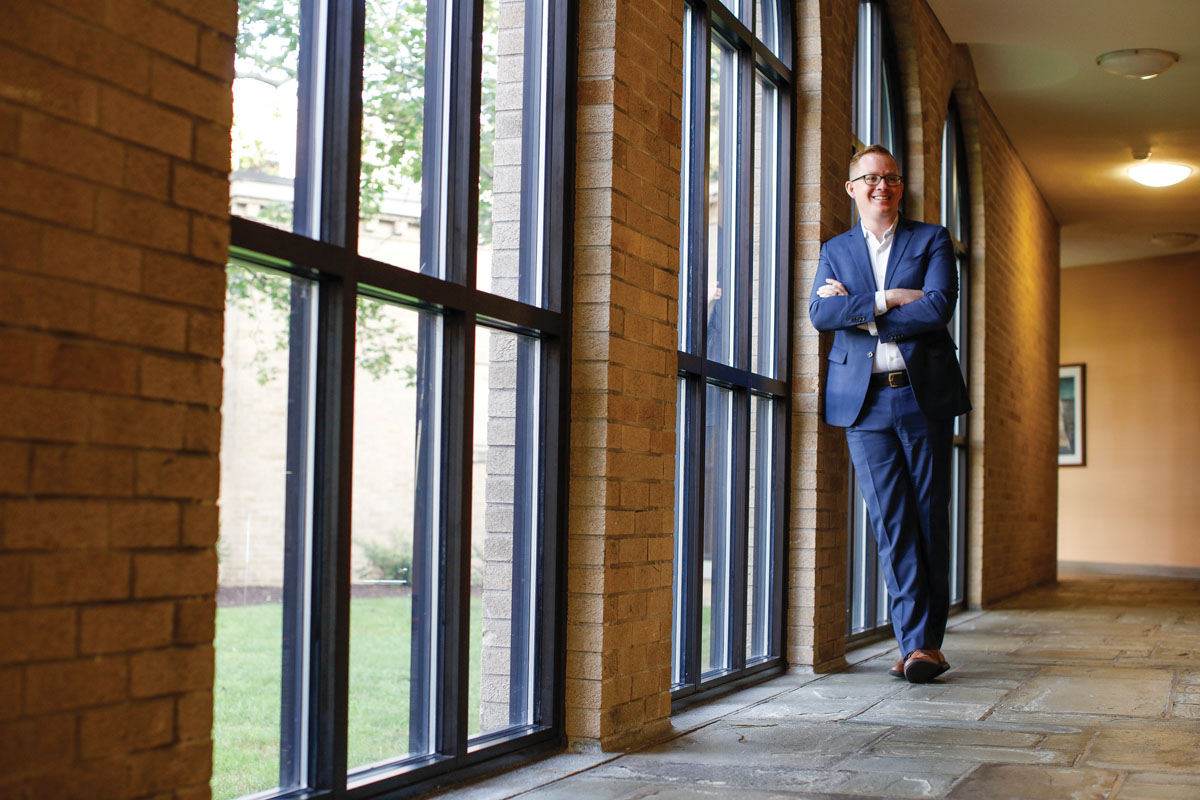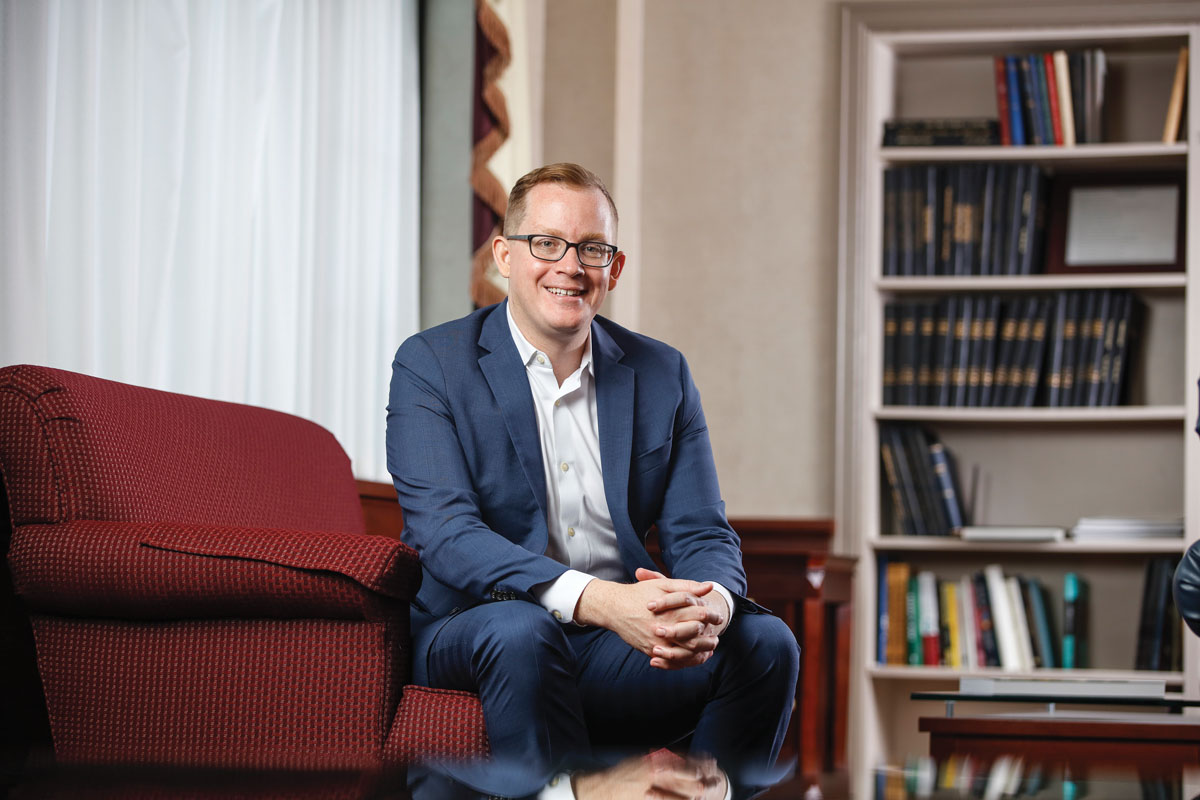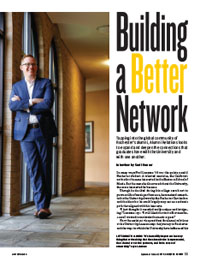Features
 LISTENING TO ALUMNI: “It’s incredibly important in every-thing that we’re doing that the alumni voice is represented, that alumni are active partners, and feel a sense of ownership,” says Lanzone. (Photo: Matt Wittmeyer)
LISTENING TO ALUMNI: “It’s incredibly important in every-thing that we’re doing that the alumni voice is represented, that alumni are active partners, and feel a sense of ownership,” says Lanzone. (Photo: Matt Wittmeyer)In many ways Paul Lanzone ’03 was the quintessential Rochester student. A talented musician, the California native first became interested in the Eastman School of Music. But the more he discovered about the University, the more interested he became.
Though he decided during his college search not to pursue a life of music performance, he remained committed to the University, drawn by the Rochester Curriculum and the idea that he could largely map out an academic path that aligned with his interests.
“I just thought it sounded really unique and intriguing,” Lanzone says. “I still liked the ties to Eastman because I wanted to maintain the music aspect.”
Now the assistant vice president for alumni relations at the University, Lanzone says his journey to Rochester and the ways in which the University have influenced his life and career have stayed with him.
“In my first year, I took a class on mysticism and poetry. I had no idea what I was getting into. The professor was fascinating, and the content was just really interesting. So the next semester, I took another religion course, and another, and eventually realized that I was passionate about these studies. I declared my major in the religion department sophomore year.”
More than a decade later, Lanzone’s enthusiasm remains.
“I really believe in the University. I believe it is a very special place. I have my personal experiences with it, but I have the great fortune now to travel the world and see the Meliora spirit in action throughout our student and alumni communities. It’s a remarkable institution that provides amazing education and formation of individuals.”
Since May 2016, Lanzone’s role has been not only to share that appreciation for the institution, but also to build on the engagement that exists among alumni and establish a strong infrastructure for alumni to connect with the University and with one another.
Over the past 15 months, he’s worked to put together a new strategic plan and a national advisory board of alumni. He’s also taken a hard look at the way alumni relations has traditionally operated.
The goal, he says, is to build a “culture of partnership” between alumni and the institution.
Have you identified any particular priorities during your first year or so?
When I came in last May, one of the first things I wanted to do was to look at all of our programs. What were we doing? What is the core work that we should be doing? How are we going to measure success? What are we going to prioritize over the next several years? I have been working to build that with our team and with many internal and external stakeholders.
A big priority in the alumni relations strategic plan is, how do we engage volunteers effectively and offer a high-quality experience across the board? We’re such a large organization, and with so many different people working with alumni volunteers—how do we make sure we’re handling those relationships in the best way for everyone?
 POWERFUL PARTNERS: As part of efforts to build a stronger sense of partnership with alumni and other constituencies, Lanzone
has led efforts to organize a national alumni advisory board and to enhance regional alumni networks. (Photo: Matt Wittmeyer)
POWERFUL PARTNERS: As part of efforts to build a stronger sense of partnership with alumni and other constituencies, Lanzone
has led efforts to organize a national alumni advisory board and to enhance regional alumni networks. (Photo: Matt Wittmeyer)How do you plan to tap into the alumni perspective on engagement with the University?
For the past year, we have been putting together an alumni board. We’re still recruiting, but we hope to have about 30 people by next year. We’re being very purposeful in the formation of the board to make sure that we have diverse representation by school, geography, class year, industry, race, ethnicity, and gender identity.
The board will also represent all of our core volunteer groups, making sure that our other alumni programs, like the Diversity Advisory Council, class programs, the regional network leadership cabinets, the school alumni councils, are part of an overarching strategy.
We have recruited an executive committee—three amazing representatives of the alumni population—who are very excited to help to lead this kind of strategic advisory group. Carol Karp ’74, a University trustee, is the chair. The vice chairs are Jane Zimelis Cohen ’67 and Drew Mittelman ’68, both of whom have been very active in alumni and volunteer circles. It will be the role of the board to make sure that we continue to have broad representation and viewpoint.
How do you balance your work in engaging alumni with the overall advancement goal of raising philanthropic support?
Alumni Relations is a unit within the Office of Advancement. Advancement’s goal is to work with our various constituents and partners to support and advance the University, through philanthropy, volunteerism, events, and personal connections.
Alumni Relations is a really critical part of the overall Advancement strategic plan. Chief Advancement Officer Tom Farrell ’88, ’90W (MS) has developed the plan, called the Rochester Model. Balancing engagement with philanthropy is a cornerstone of that plan.
We know that when a University has a strong, connected alumni community, the institution and the alumni community benefit in a number of ways. You certainly see that in philanthropic support, but you also see it in internships and job placement for students. You see it in the institution’s reputation nationally and internationally.
It’s a self-fulfilling cycle: if you have alumni who feel good about the University and stay connected, you see a positive impact on the University and its alumni community.
What will alumni see as the plan rolls out?
As it became clear that we needed to better align our volunteer and alumni voices into our decision making, one area that we began focusing on is building and strengthening our regional network. We think that our regional strategy is really going to be the foundation of our alumni relations work, providing an infrastructure where all of our programs and activities can play out. We have designated a staff person for each major region to convene our volunteers in the area and to come up with annual plans for each region.
What events should we be doing? What’s working in the region and what’s not? Do we need more admissions recruiters in a particular area? Or, are there better companies we can tap into for internships and job opportunities for students?
And making sure that we’re involving alumni leaders in that conversation and they feel that alumni can own their Rochester network.
Other priorities include class-based activities, beyond milestone reunions. And we’re building newer programs to focus on diversity and inclusion efforts, alumni career services, and helping student groups stay in touch with alumni over time.
Why did you want to lead in this way?
As an alumnus, as someone who’s been in the industry for a number of years, I have long been intrigued by the potential for Rochester. When I saw the Rochester Model plan and learned about Tom’s vision and the support he has from President Seligman and the Board of Trustees, it was exactly what I had wanted for the University. I thought it sounded exciting, and I knew it was time for me to be part of it.
We, as the University, know that we can and should better engage and support our alumni community. And we have been working very thoughtfully on how to do that.
It’s incredibly important in everything that we’re doing that alumni are active partners and feel a sense of ownership—and that, at a very strategic, high level, the alumni voice is being represented.

